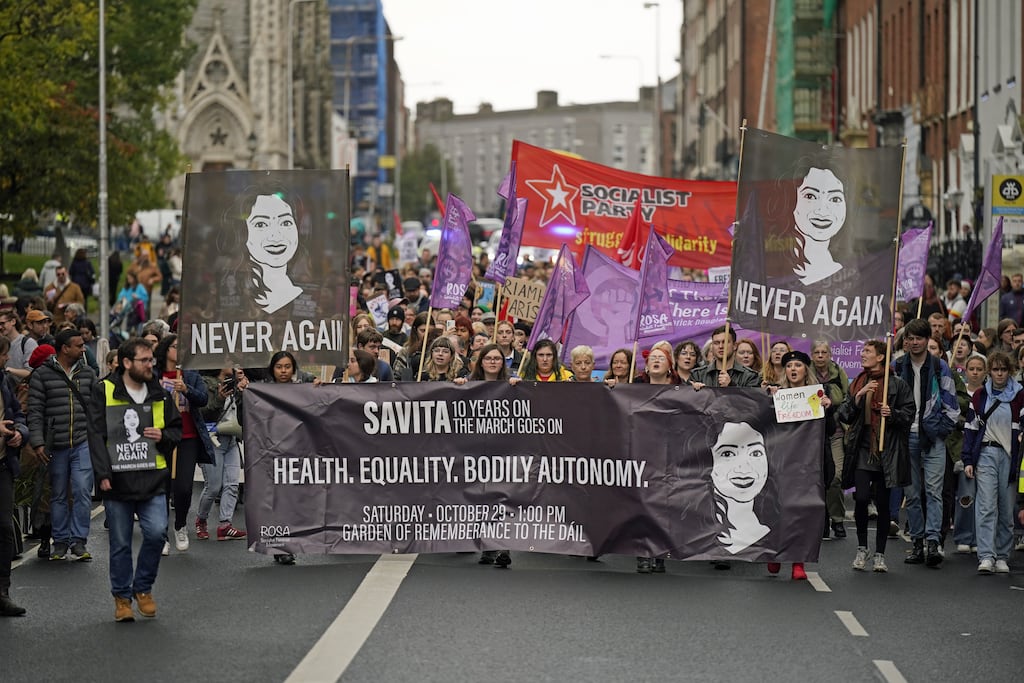The Irish expect the worst to happen at any moment. And they have what my colleague Dan Barry calls “a wry acceptance of mortality”.
Still, Ireland was shaken to its core in 2012 by the death of Savita Halappanavar, a beautiful, sparkling 31-year-old Indian immigrant, a dentist married to an Indian engineer. Savita was expecting her first child. She wore a new dress for the baby shower and prayed for the future. But that night she got sick. She went to a Galway hospital, where she was crushed to learn that her foetal membranes were bulging and her 17-week-old foetus would not survive.
Knowing her life was at stake, she begged the medical staff to remove the foetus. As Kitty Holland wrote in Savita: The Tragedy That Shook a Nation, a midwife explained to her, “It’s a Catholic thing. We don’t do it here.” Ireland had a long history of punishing women, sending them to religious asylums if they were pregnant out of wedlock or deemed “fallen”. Savita developed septic shock and died four days after her baby girl, whom she named Prasa, was stillborn.
[ How the death of Savita Halappanavar revolutionised IrelandOpens in new window ]
That tragedy jolted the turbulent debate in Ireland about the right of women to control their bodies. Savita’s story was vividly evoked by women and men when I covered the 2018 referendum to revoke the Vatican-approved Eighth Amendment of the Irish Constitution, which made abortions illegal, even in cases of rape or incest. That draconian amendment had women selling their cars and going to loan sharks to get the money to fly to England for procedures. It stamped women with a Scarlet Letter and psychological trauma because they felt their country had turned its back on them.
I remember, as I reported on the vote, having a flash of gratitude that I lived in the United States and not Ireland. I thought to myself that I would hate living in such a benighted country shaped by religious fanatics.
But now I am. Religious fanatics on the supreme court have yanked the US back to back alleys. American women are punished, branded with Scarlet Letters, forced to flee to get procedures.
And we have our own fraught case of a 31-year-old begging for a termination: Kate Cox, a married Texas mother of two who was thrilled to be pregnant until she was told that her foetus had a deadly chromosomal abnormality. Continuing the pregnancy could also keep Cox from getting pregnant again.
“I kept asking more questions, including how much time we might have with her if I continued the pregnancy,” Cox wrote in the Dallas Morning News. “The answer was maybe an hour – or at most, a week. Our baby would be in hospice care from the moment she is born if she were to be born alive.”
Cox, more than 20 weeks pregnant, had to leave Texas to have an abortion because the state’s mega-MAGA attorney general, Ken Paxton, threatened to prosecute “hospitals, doctors or anyone else” who helped her, even floating first-degree felony charges. The case has become so politically toxic that even the voluble senator Ted Cruz, who is running for reelection next year, has clammed up about it. Republican pollster Kellyanne Conway, playing school nurse, warned Republicans on the Hill to talk less about banning abortion and more about the benefits of contraception.
I’m sure even Donald Trump, who was once pro-choice but now panders to evangelicals, has qualms about criminalising abortion. It’s a political loser and could cost him the election if women are supermobilised. He called governor Ron DeSantis’ six-week abortion ban in Florida “a terrible thing and a terrible mistake”. Once Trump bragged about appointing the conservative justices on the court who were pivotal in overturning Roe v Wade. But that won’t be a great sales pitch in the general election.
It is outrageous that such an important right in the US was stripped away by a handful of cloistered, robed zealots, driven by religious doctrine, with no accountability.
But the Savonarola wing of the US supreme court – all Catholics except Neil Gorsuch, who was raised Catholic and went to the same suburban Washington Catholic prep school as Brett Kavanaugh – could go to even more extreme lengths. The court announced Wednesday that it will consider curtailing the availability of a pill used to terminate first-trimester pregnancies. Soon, it’ll be mandating the rhythm method.
An explosive New York Times article by Jodi Kantor and Adam Liptak revealed that justice Samuel Alito was even more underhanded than we knew as he plotted to engineer “a titanic shift in the law” by vitiating Roe. Conservative judges who assured the Senate that Roe was settled law in their confirmation hearings could barely wait until justice Ruth Bader Ginsburg died to throw it in the constitutional rights rubbish bin.
The more we learn, the more infuriating it is that our lives and choices about our bodies are determined by conniving radicals. The supreme court is way, way out of order. – This article originally appeared in the New York Times.















